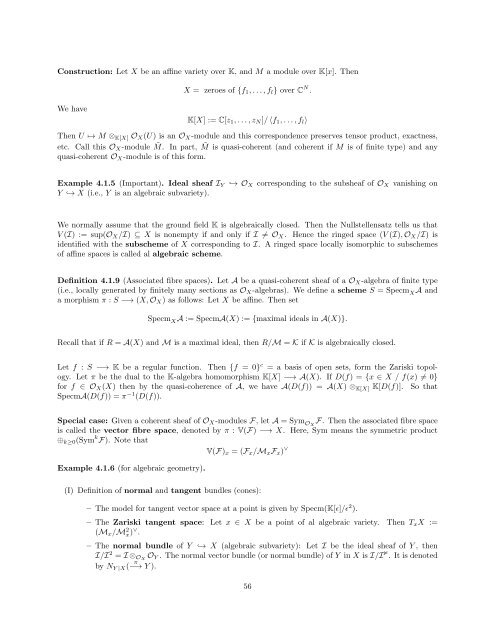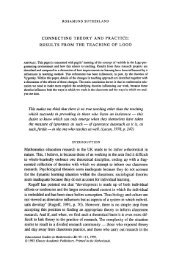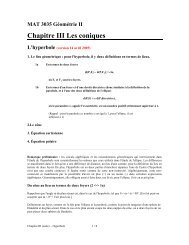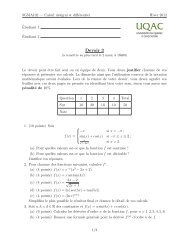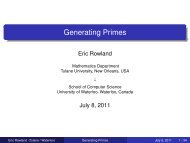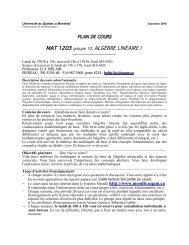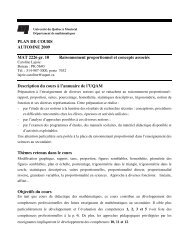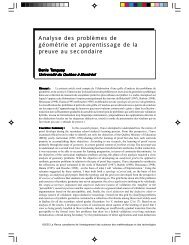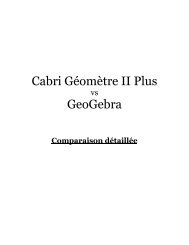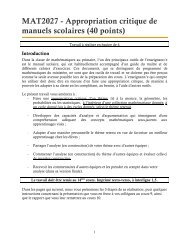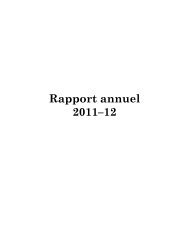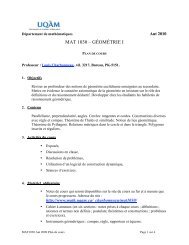COMPLEX GEOMETRY Course notes
COMPLEX GEOMETRY Course notes
COMPLEX GEOMETRY Course notes
You also want an ePaper? Increase the reach of your titles
YUMPU automatically turns print PDFs into web optimized ePapers that Google loves.
Construction: Let X be an affine variety over K, and M a module over K[x]. Then<br />
X = zeroes of {f 1 , . . . , f l } over C N .<br />
We have<br />
K[X] := C[z 1 , . . . , z N ]/ 〈f 1 , . . . , f l 〉<br />
Then U ↦→ M ⊗ K[X] O X (U) is an O X -module and this correspondence preserves tensor product, exactness,<br />
etc. Call this O X -module ˜M. In part, ˜M is quasi-coherent (and coherent if M is of finite type) and any<br />
quasi-coherent O X -module is of this form.<br />
Example 4.1.5 (Important). Ideal sheaf I Y<br />
Y ↩→ X (i.e., Y is an algebraic subvariety).<br />
↩→ O X corresponding to the subsheaf of O X vanishing on<br />
We normally assume that the ground field K is algebraically closed. Then the Nullstellensatz tells us that<br />
V (I) := sup(O X /I) ⊆ X is nonempty if and only if I ≠ O X . Hence the ringed space (V (I), O X /I) is<br />
identified with the subscheme of X corresponding to I. A ringed space locally isomorphic to subschemes<br />
of affine spaces is called al algebraic scheme.<br />
Definition 4.1.9 (Associated fibre spaces). Let A be a quasi-coherent sheaf of a O X -algebra of finite type<br />
(i.e., locally generated by finitely many sections as O X -algebras). We define a scheme S = Specm X A and<br />
a morphism π : S −→ (X, O X ) as follows: Let X be affine. Then set<br />
Specm X A := SpecmA(X) := {maximal ideals in A(X)}.<br />
Recall that if R = A(X) and M is a maximal ideal, then R/M = K if K is algebraically closed.<br />
Let f : S −→ K be a regular function. Then {f = 0} c = a basis of open sets, form the Zariski topology.<br />
Let π be the dual to the K-algebra homomorphism K[X] −→ A(X). If D(f) = {x ∈ X / f(x) ≠ 0}<br />
for f ∈ O X (X) then by the quasi-coherence of A, we have A(D(f)) = A(X) ⊗ K[X] K[D(f)]. So that<br />
SpecmA(D(f)) = π −1 (D(f)).<br />
Special case: Given a coherent sheaf of O X -modules F, let A = Sym OX<br />
F. Then the associated fibre space<br />
is called the vector fibre space, denoted by π : V(F) −→ X. Here, Sym means the symmetric product<br />
⊕ k≥0 (Sym k F). Note that<br />
V(F) x = (F x /M x F x ) ∨<br />
Example 4.1.6 (for algebraic geometry).<br />
(I) Definition of normal and tangent bundles (cones):<br />
– The model for tangent vector space at a point is given by Specm(K[ɛ]/ɛ 2 ).<br />
– The Zariski tangent space: Let x ∈ X be a point of al algebraic variety. Then T x X :=<br />
(M x /M 2 x) ∨ .<br />
– The normal bundle of Y ↩→ X (algebraic subvariety): Let I be the ideal sheaf of Y , then<br />
I/I 2 = I ⊗ OX O Y . The normal vector bundle (or normal bundle) of Y in X is I/I . It is denoted<br />
by N Y |X ( −→ π<br />
Y ).<br />
56


